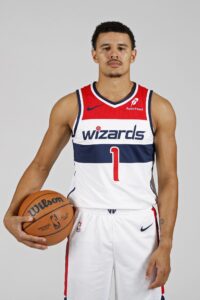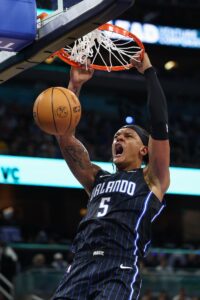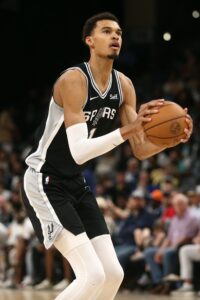Decisions on rookie scale options for the 2025/26 season were due on Thursday — any team that wanted to exercise a third- or fourth-year option on a player for next season was required to do so by October 31.
As is typically the case, a huge majority of those options were picked up. Even for top picks, who are paid higher salaries due to the NBA’s rookie scale, those third- and fourth-year options are relatively team-friendly. So unless a player has fallen well short of his team’s expectations, it generally makes sense to lock in his salary for the following season at this point.
However, not every player with a 2025/26 team option had it exercised by Thursday’s deadline. A player who had his option declined will now be on track to reach unrestricted free agency during the summer of 2025, assuming he’s not waived before then. At the end of the season, his team won’t be able to offer him a starting salary that exceeds the value of his declined option.
Listed below are the players who had their options turned down, followed by the players whose options were exercised. If a player had his option picked up, his ’25/26 salary is now guaranteed and he won’t be eligible for free agency until at least 2026.
Declined options:
- Johnny Davis, Wizards (fourth year, $6,746,229)

- AJ Griffin, Rockets (fourth year, $5,967,137)
- Note: Griffin’s fourth-year option was declined when he was bought out and waived.
- Jake LaRavia, Grizzlies (fourth year, $5,163,127)
- David Roddy, Hawks (fourth year, $4,831,766)
- MarJon Beauchamp, Bucks (fourth year, $4,781,276)
- Wendell Moore, Pistons (fourth year, $4,574,283)
- Patrick Baldwin, Wizards (fourth year, $4,420,156)
- Jalen Hood-Schifino, Lakers (third year, $4,064,640)
We saw more rookie scale options turned down this season than usual, which is perhaps a side effect of the NBA’s new tax apron system that has teams more wary than ever of carrying extraneous salary.
It’s also a little unusual to see so many players remain on their teams’ respective rosters after having their options declined. A year ago, for instance, five of the six of the players who didn’t have their rookie scale options exercised ahead of October’s deadline were waived outright, resulting in their options being declined as part of the transaction. That only happened with Griffin this year, and only because he chose to step away from basketball.
Among the players whose fourth-year options were declined, Davis, Moore, and Baldwin were the least surprising decisions. I was half-expecting one or more of them to be cut during the offseason or preseason. I also wasn’t shocked to see the Hawks and Bucks pass on Roddy’s and Beauchamp’s options, respectively. Neither player has established himself as a reliable rotation piece, and Milwaukee especially has luxury tax penalties to consider — the Bucks are better off replacing Beauchamp’s $4.8MM salary with a minimum-salary contract in 2025/26.
I didn’t view LaRavia as a lock to have his option picked up, but I thought the Grizzlies might pull the trigger on it, since he’s playing rotation minutes in the early going this season. That decision looks like it’s as much about roster flexibility as it is financial flexibility — Memphis has about $157MM in guaranteed money on its books for next season, which is well below the luxury tax line, but that’s for 12 players. Not locking in LaRavia’s contract gives the club some more room to maneuver with those last few roster spots.
Of all these option decisions, the Lakers declining Hood-Schifino’s was the biggest eyebrow-raiser. It’s rare for a player to have his third-year option turned down just a year after being made a first-round pick. It’s even rarer when it’s a player who was drafted as high as Hood-Schifino (No. 17). The Lakers have their cap situation to consider, and clearing Hood-Schifino from the books for 2025/26 could created some additional spending flexibility, but it’s a tacit acknowledgment from the front office that its top 2023 pick was a miss.
Exercised options:
Fourth year:
Note: These players will become eligible for rookie scale extensions in July of 2025. If they’re not extended, they’ll be on track for restricted free agency in 2026.
- Paolo Banchero, Magic ($15,334,769)

- Chet Holmgren, Thunder ($13,731,368)
- Jabari Smith, Rockets ($12,350,392)
- Keegan Murray, Kings ($11,144,093)
- Jaden Ivey, Pistons ($10,107,163)
- Bennedict Mathurin, Pacers ($9,187,573)
- Shaedon Sharpe, Trail Blazers ($8,399,983)
- Dyson Daniels, Hawks ($7,707,709)
- Jeremy Sochan, Spurs ($7,096,231)
- Ousmane Dieng, Thunder ($6,670,882)
- Jalen Williams, Thunder ($6,580,997)
- Jalen Duren, Pistons ($6,483,144)
- Ochai Agbaji, Raptors ($6,383,525)
- Mark Williams, Hornets ($6,276,531)
- Tari Eason, Rockets ($5,675,766)
- Dalen Terry, Bulls ($5,399,118)
- Malaki Branham, Spurs ($4,962,033)
- Christian Braun, Nuggets ($4,921,797)
- Walker Kessler, Jazz ($4,878,938)
- Blake Wesley, Spurs ($4,726,328)
- Nikola Jovic, Heat ($4,445,417)
- Peyton Watson, Nuggets ($4,356,476)
These 22 players who had their fourth-year options exercised, along with the seven listed in the section above who had their fourth-year options declined, were drafted in the first round in 2022.
The 30th first-round pick in that class was TyTy Washington, who was waived by the Thunder in August 2023. Washington had both his third- and fourth-year options declined as part of that transaction last summer.
Third year:
Note: Teams will have to make fourth-year option decisions for 2026/27 on these players by October 31, 2025.
- Victor Wembanyama, Spurs ($13,376,880)

- Brandon Miller, Hornets ($11,968,800)
- Scoot Henderson, Trail Blazers ($10,748,040)
- Amen Thompson, Rockets ($9,690,600)
- Ausar Thompson, Pistons ($8,775,000)
- Anthony Black, Magic ($7,970,280)
- Bilal Coulibaly, Wizards ($7,275,600)
- Jarace Walker, Pacers ($6,665,520)
- Taylor Hendricks, Jazz ($6,127,080)
- Cason Wallace, Thunder ($5,820,240)
- Jett Howard, Magic ($5,529,720)
- Dereck Lively II, Mavericks ($5,253,360)
- Gradey Dick, Raptors ($4,990,560)
- Jordan Hawkins, Pelicans ($4,741,320)
- Kobe Bufkin, Hawks ($4,503,720)
- Keyonte George, Jazz ($4,278,960)
- Jaime Jaquez, Heat ($3,861,600)
- Brandin Podziemski, Warriors ($3,687,960)
- Cam Whitmore, Rockets ($3,539,760)
- Noah Clowney, Nets ($3,398,640)
- Dariq Whitehead, Nets ($3,262,560)
- Kris Murray, Trail Blazers ($3,132,000)
- Olivier-Maxence Prosper, Mavericks ($3,007,080)
- Marcus Sasser, Pistons ($2,886,720)
- Ben Sheppard, Pacers ($2,790,720)
- Nick Smith Jr., Hornets ($2,710,680)
- Brice Sensabaugh, Jazz ($2,693,760)
- Julian Strawther, Nuggets ($2,674,200)
- Kobe Brown, Clippers ($2,654,880)
As usual, nearly every player from the 2023 draft class had his third-year option picked up, with 29 of 30 exercised. As noted above, Hood-Schifino was the only player from 2023’s first round who is on track to become an unrestricted free agent in 2025.
For a team-by-team breakdown of this year’s rookie scale option decisions for the 2025/26 season, along with full stories on each decision, you can check out our tracker.
Nice decision LeBron. So much for developing young talent on an impotent (save for the injury prone Davis) aging roster.
C’mon Bron isn’t running the show, he’s just a player? People who believe that are the very people who believe Bron is the GOAT. The lakeshow mess has only just begun. YAY, lakers stink.